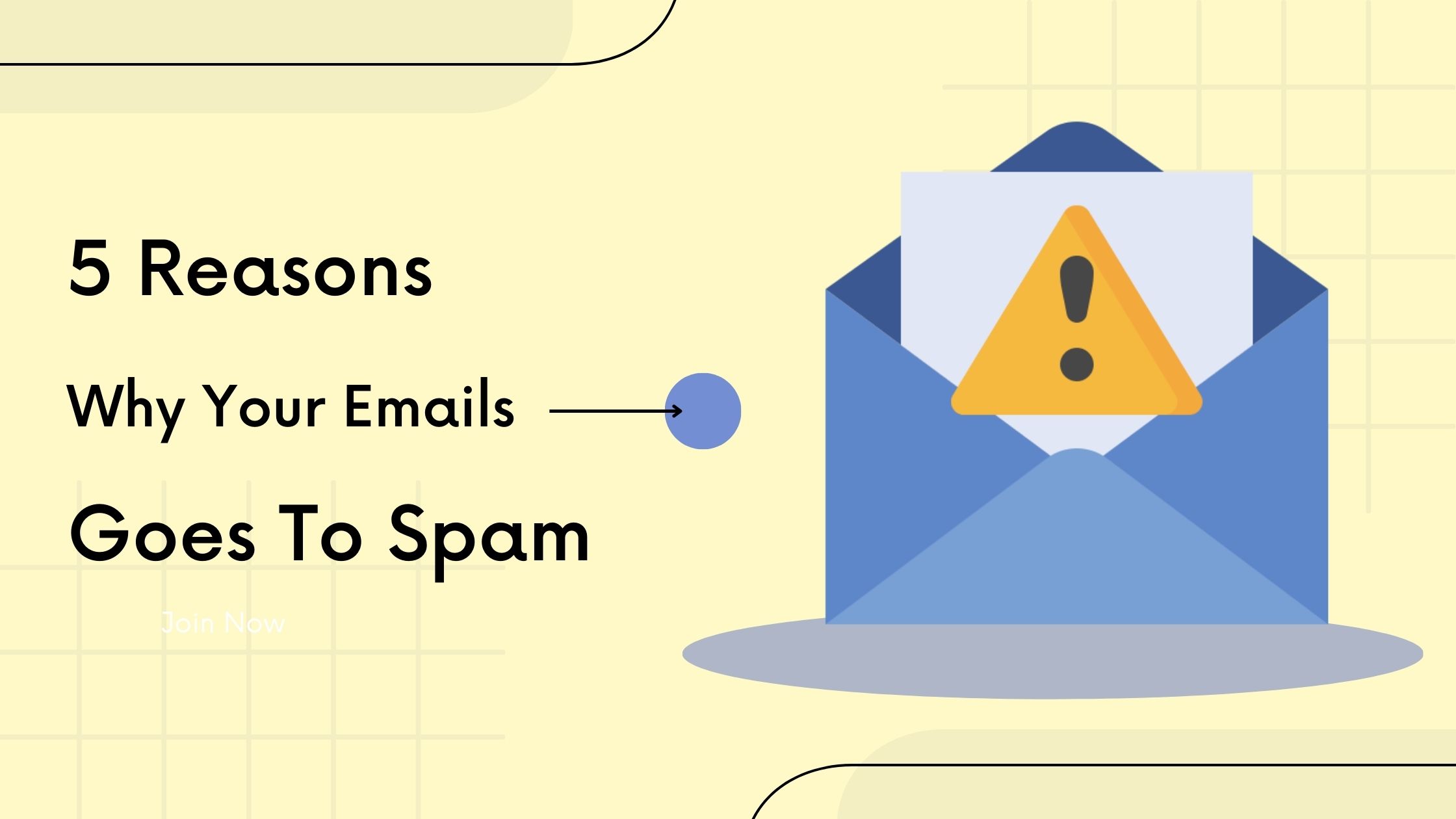Are your emails ending up in the spam folder instead of reaching the intended inbox? This common problem can be frustrating, but with the right knowledge and techniques, it can be prevented. In this blog post, we’ll explore the top five reasons why your emails go to spam. And provide you with solutions for better email deliverability. From understanding the email filtering process to crafting compelling subject lines, we’ll cover it all. Get ready to improve your email marketing game with our comprehensive guide on SEO for email deliverability.
1- Spammy Email Content’
Spammy email content refers to the type of email that is designed to deceive the recipient or promote irrelevant, low-quality, or malicious products or services. These emails are often unwanted and irritating, typically marked as spam by email filters or recipients. The main goal of spammy email content is to trick people into clicking on a link or sharing personal information. Making them vulnerable to scams, phishing attacks, and other forms of online fraud.
Some common examples of spammy email content include:
- Phishing scams: Phishing scams are emails that appear to be from a trusted source, such as a bank or an online retailer, and ask for sensitive information, such as a password or credit card number.
- Unsolicited sales pitches: These are emails that promote products or services without the recipient’s prior consent or interest. For example, emails that offer weight loss pills or work-from-home opportunities.
- Adult content: These are emails that contain sexually explicit or adult material, often disguised as advertisements or special offers.
- Lotteries and prizes: These are emails that claim the recipient has won a prize or a lottery, but in reality. They are just a ploy to get the recipient to provide personal information. Spam Folder
- Viagra or other prescription drugs: These are emails that promote cheap and counterfeit versions of prescription drugs, such as Viagra.
Common Spammy Words.
Here is a list of some commonly used spammy words in email subject lines or content:
- Free
- Earn money fast
- Limited time
- Increase sales
- Double your income
- Get paid
- #1 rated
- Amazing
- Order now
- Work from home
- Risk-free
- Satisfaction guaranteed
- Viagra
- You’re a winner!
- Avoid bankruptcy
- Urgent
- Exclusive
- Big bucks
- This isn’t a scam
- Limited time offer
Note that the use of these words alone does not guarantee that an email is a spam. But they are commonly associated with spammy emails and are often flagged by email filters. It is important to use clear, concise language in your emails to avoid triggering spam filters. And ensure your messages reach the intended inbox. Spam Folder
In conclusion, spammy email content is designed to deceive the recipient and promote low-quality products or services. It is essential to be cautious when opening emails, especially those from unknown sources. To avoid falling victim to scams or other forms of online fraud.
2- Email Design Doesn’t Follow the Protocols
Email design that does not follow the protocols refers to the use of inconsistent. Or non-standard design elements in email content that can negatively impact the appearance and usability of the email. This can occur when the design of the email does not adhere to the best practices. And standards established for email design, such as using HTML and CSS that are supported by most email clients.
Some examples of when email design doesn’t follow the protocols include:
- Inconsistent font sizes and styles: Using different font sizes and techniques within the same email can make the content appear. Unprofessional and difficult to read that’s why your mail goes to your Spam Folder.
- Poor use of images: Inserting large or inappropriate images into an email, or failing to optimize images for size and resolution, can cause the email to load slowly or appear broken.
- Non-standard HTML and CSS: Using HTML and CSS that are not supported by most email clients can result in the email appearing differently across different devices and email clients.
- Inconsistent layout: Using inconsistent or non-standard layouts. Such as placing elements in unexpected locations or using non-standard spacing can make the email difficult to understand and navigate.
- Inadequate testing: Failing to test the email design across different devices and email clients can result in the email appearing differently than intended, potentially causing confusion or frustration for the recipient.
Read This: Influencer marketing benefits and how to get started
To ensure that your email design follows the protocols, it is essential to follow best practices and standards for email design, including using supported HTML and CSS, optimizing images for size and resolution, and testing the design across different devices and email clients.
Additionally, it is important to use a consistent and professional design style, such as using a consistent font size and style and using a clear and intuitive layout. By following these best practices, you can ensure that your email content is professional, readable, and accessible to all recipients not in Spam Folder.
Best Email Templates For Professional Emails
Here are some of the best email templates for professional emails:
- Simple text template: This template consists of a simple, plain text email with a professional font, limited formatting, and a clear and concise message. This template is ideal for short and straightforward messages, such as appointment reminders or follow-up emails.
- Formal business template: This template is designed for formal business communications, such as job offers, contract proposals, or client updates. It includes a header with the sender’s logo or name, a clear and structured layout, and professional font choices.
- Newsletter template: This template is designed for email newsletters, such as company updates or industry news. It includes sections for featured articles, recent news, and call-to-action buttons. This template is designed to be visually appealing and easy to navigate.
- Product announcement template: This template is designed for product announcements, such as the launch of a new product or service. It includes eye-catching images, clear product descriptions, and call-to-action buttons.
- Invitation Template: This template is designed for event invitations, such as a company conference or networking event. It includes details about the event, a clear and attractive design, and RSVP options.
It’s important to note that these are just examples, and the best email template for you will depend on your specific needs and the type of email you are sending. When choosing an email template, it is important to consider factors such as the type of message you are sending, the recipient audience, and the overall design style that aligns with your brand.
3- Your Subject Line is Misleading (Spam Folder)
A misleading subject line is a subject line in an email that does not accurately reflect the content of the email. This can occur when the subject line is overly sensational, vague, or makes false promises.
A misleading subject line can have several negative effects, including:
- Decreased open rates: If the recipient feels that the subject line is not relevant or trustworthy, they are less likely to open the email.
- Increased spam complaints: If the recipient feels misled or deceived by the subject line, they are more likely to mark the email as spam, which can impact the sender’s email reputation and delivery rate.
- Decreased engagement: If the recipient feels that the content of the email does not align with the subject line, they are less likely to engage with the content, such as clicking on links or responding to calls to action.
Read This: The Ultimate Guide to On-Page SEO
Here are some examples of misleading subject lines:
- “You Won the Lottery!” – This subject line may be misleading if the recipient did not win the lottery, as it creates false expectations.
- “Get Rich Quick!” – This subject line may be misleading if the content of the email is not actually about a way to get rich quickly, as it creates false promises.
- “Breaking News: Exclusive Story!” – This subject line may be misleading if the content of the email is not breaking news or an exclusive story, as it creates false expectations.
To ensure that your subject line is not misleading, it is important to write subject lines that accurately reflect the content of the email and to avoid using sensational, vague, or false promises. Additionally, it is important to test the subject line to ensure that it resonates with the target audience and encourages them to open the email. By using clear, concise, and accurate subject lines, you can build trust with your recipients and improve the overall effectiveness of your email marketing.
How to Avoid It?
Here are some tips to avoid having a misleading subject line:
- Be specific and clear: Use a subject line that accurately describes the content of the email. Avoid using vague or sensational language that does not reflect the actual content of the email.
- Test your subject line: Before sending your email, test the subject line to ensure that it accurately reflects the content of the email and that it resonates with your target audience. You can use A/B testing to compare different subject lines and see which one performs best.
- Keep it concise: Keep your subject line concise and to the point. Aim for fewer than 10 words and avoid using unnecessary words or punctuation.
- Avoid using all caps or excessive punctuation: Using all caps or excessive punctuation can make your subject line appear spammy and can decrease the open rates of your email.
- Avoid false promises: Don’t make false promises or create false expectations in your subject line. This can damage your reputation and lead to spam complaints.
- Personalize the subject line: Personalizing the subject line with the recipient’s name or other personal information can increase the open rates of your email and help avoid misleading subject lines.
By following these tips, you can avoid having a misleading subject line and improve the overall effectiveness of your email marketing. A clear and accurate subject line can help you build trust with your recipients, increase open rates, and drive engagement with your content.
4- Bad IP/Domain reputation
A bad IP/domain reputation refers to a situation where a particular IP address or domain is seen as a source of spam or unwanted emails. This can occur when a large number of emails sent from a particular IP address or domain are marked as spam, or if the IP address or domain has a history of being used to send spam.
A bad IP/domain reputation can have several negative effects, including:
- Email filtering: Webmail providers such as Gmail, Yahoo, and Outlook use filters to determine which emails should be delivered to the inbox and which should be sent to the spam folder. If an IP address or domain has a bad reputation, the likelihood of emails from that IP address or domain being filtered to the spam folder increases.
- Low email deliverability: If a large percentage of emails from a particular IP address or domain are being filtered to the spam folder, the overall deliverability of emails from that IP address or domain can decrease. This means that a significant number of emails may not reach the intended recipients.
- Damage to reputation: A bad IP/domain reputation can damage the reputation of a business, brand, or individual. It can give the impression that the sender is a source of spam or unwanted emails, which can harm customer relationships and negatively impact the brand’s image.
Recommended: Choosing the Right Web Hosting Plan for Your Website
Here are some examples of what can cause a bad IP/domain reputation:
- High bounce rates: If a high percentage of emails sent from a particular IP address or domain is bounced back (undeliverable). This can indicate that the recipient’s email address is invalid or that the IP address or domain is being used to send spam.
- Use of purchased or rented email lists: If an IP address or domain is used to send emails to purchased. Rented email lists can result in a high number of spam complaints and a decrease in email deliverability.
To maintain a good IP/domain reputation, it is important to follow best practices for email marketing. Such as using opt-in email lists, and avoiding the use of purchased or rented email lists. And maintaining a low bounce rate and spam complaint rate.
Additionally, it is important to monitor your IP/domain reputation and take steps to improve it if necessary. This can include removing invalid email addresses from your list. Sending fewer emails, or using a different IP address or domain for your email marketing efforts. By maintaining a good IP/domain reputation. You can ensure that your emails are delivered to the inbox and that your email marketing efforts are effective.
How To Avoid It?
Here are some tips to follow while purchasing an expired domain:
- Check domain history: Use tools like Wayback Machine to check the history of the domain. If it was used for any spammy or unethical purposes in the past.
- Check the backlinks: Use a backlink analysis tool to see the quality and number of backlinks to the domain. If the domain has a large number of low-quality or spammy backlinks. This may indicate that it has a poor reputation and should be avoided.
- Check for penalties: Check if the domain has any penalties from search engines such as Google. If the domain has been penalized, it may be difficult to recover from this and improve its search engine ranking.
- Check the domain’s age: Older domains generally have more credibility and a better reputation than newer domains. Consider purchasing an older domain if possible.
- Consider the niche: Consider the niche the domain belongs to and the type of content previously published on the domain. If the niche is unrelated to your business or the content is spammy or unethical. It may be best to avoid the domain and emails going to Spam Folder.
- Check the content: Check the content of the domain to see if it is high quality and relevant to your business. If the content is poor or irrelevant, it may be difficult to rank the domain in search engines.
- Get professional advice: Consider seeking the advice of a domain expert or SEO professional before making a purchase. They can help you assess the potential of the domain and determine if it is worth purchasing.
By following these tips, you can reduce the risk of purchasing an expired domain. A poor reputation ensures that your investment will be a valuable asset to your business.
5- You Have Low Mailbox Usage
Low mailbox usage is a common issue that can impact the deliverability of your emails. It refers to the infrequency of sending and receiving emails from a particular email address or domain. Here are some examples and solutions for low mailbox usage:
- Inactive email addresses: If you have a large number of inactive email addresses on your mailing list. This can lead to low mailbox usage. To avoid this, regularly clean your mailing list of inactive email addresses.
- Lack of engagement: If your emails are not receiving high open and click-through rates. This can indicate a lack of engagement and lead to low mailbox usage. To improve engagement, make sure your emails are relevant, valuable, and engaging to your subscribers.
- Infrequent email sending: If you only send emails infrequently, this can also lead to low mailbox usage. It is recommended to send emails regularly to maintain high mailbox usage and ensure that your emails are delivered to the inbox.
- Poor email content: If your email content is low quality or not relevant to your subscribers. This can also lead to low mailbox usage. To improve your content, consider the needs and interests of your subscribers. And create content that is valuable and relevant to them.
- Avoid being blacklisted by ensuring your email content is high quality and following best practices for email deliverability, if your IP address or domain is listed on an email blacklist, this can lead to low mailbox usage.
By addressing these issues, you can improve your mailbox usage and ensure that your emails are delivered to the inbox and received by your subscribers.
How To Improve Low Mailbox Usage?
Here are some tips to improve low mailbox usage:
- Clean your email list: Regularly remove inactive email addresses from your list to improve the overall health and engagement of your email subscribers.
- Send relevant content: Make sure your emails are valuable and relevant to your subscribers to improve engagement and encourage higher open and click-through rates.
- Send emails regularly: Consistently sending emails regularly can help maintain high mailbox usage and ensure that your emails are delivered to the inbox.
- Segment your email list: Segment your email list based on subscriber interests and behaviors to ensure that your emails are targeted and relevant to each group.
- Test and optimize your emails: Test and optimize different aspects of your emails such as subject lines, send time, and content to improve engagement and mailbox usage.
- Monitor email deliverability: Use email deliverability tools to monitor the deliverability of your emails and identify any issues that may be affecting mailbox usage.
- Provide an easy opt-out option: Make it easy for subscribers to unsubscribe from your emails if they are no longer interested. This can reduce the number of spam complaints and improve the reputation of your domain.
Read This: The importance of developing social media branding
By following these tips, you can improve your low mailbox usage and ensure that your emails are delivered to your inbox.
In conclusion, there are several reasons why your emails may end up in the spam folder. Including spammy email content, and email design that doesn’t follow protocols. Misleading subject lines, a bad IP/domain reputation, and low mailbox usage.
Avoid spammy words in your email content, design emails that follow protocols, using clear and honest subject lines. Maintaining a good IP/domain reputation, and improving low mailbox usage. You can increase the chances of your emails reaching the inbox, not the spam folder.
Additionally, it is important to regularly monitor your email deliverability and adjust your strategy as needed. By following these tips, you can ensure that your emails are delivered to the inbox and effectively reach your target audience.





